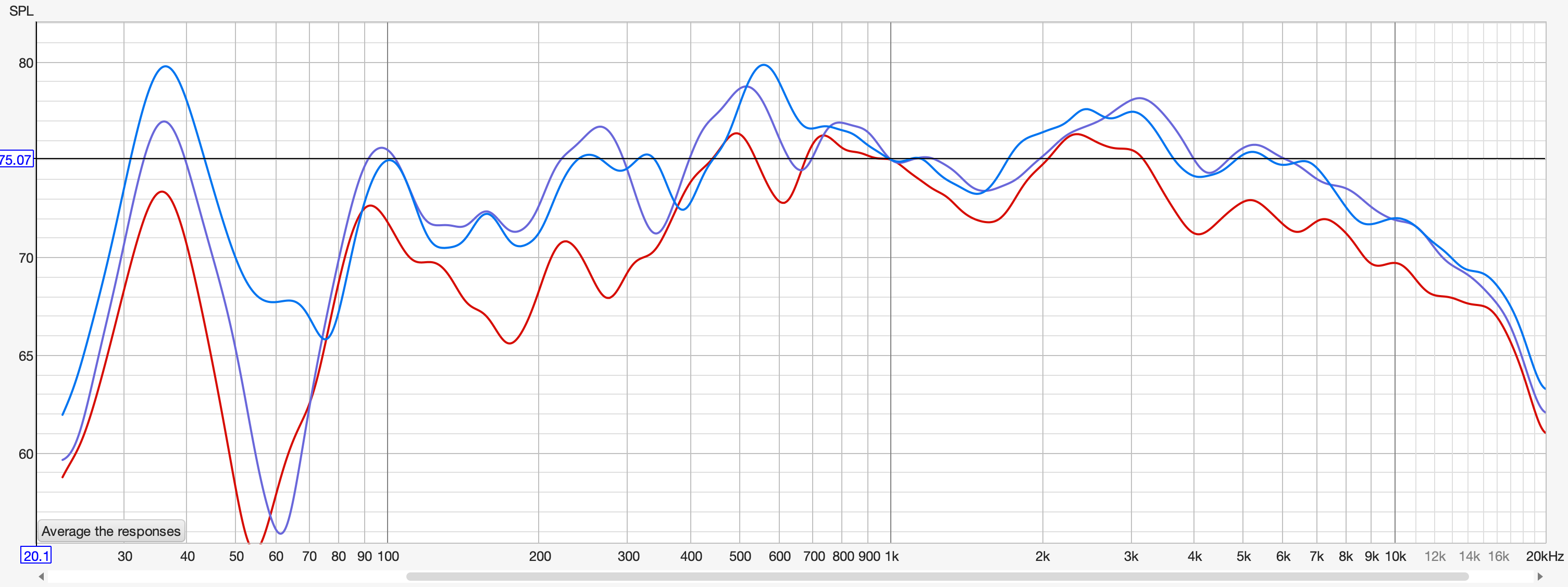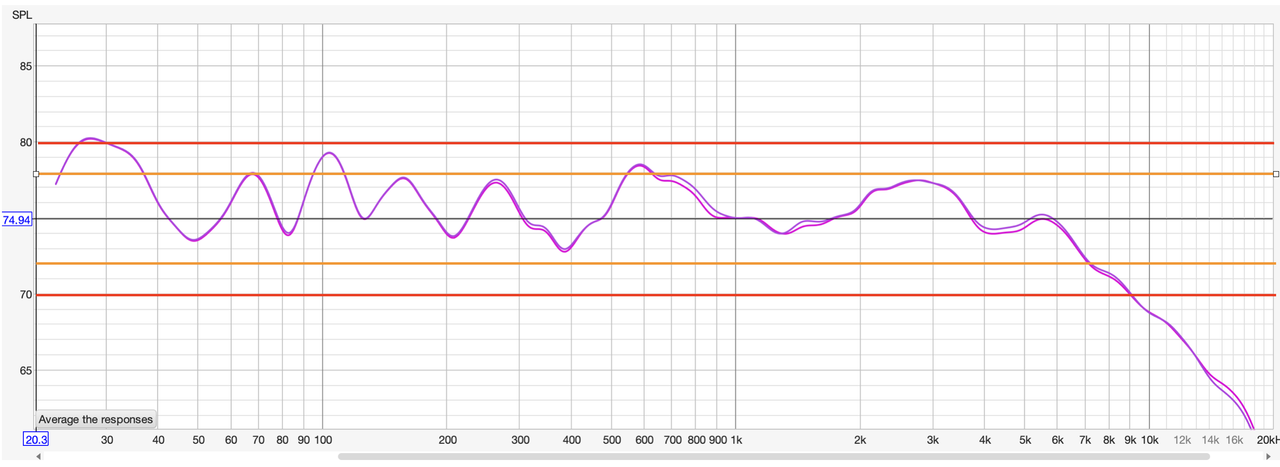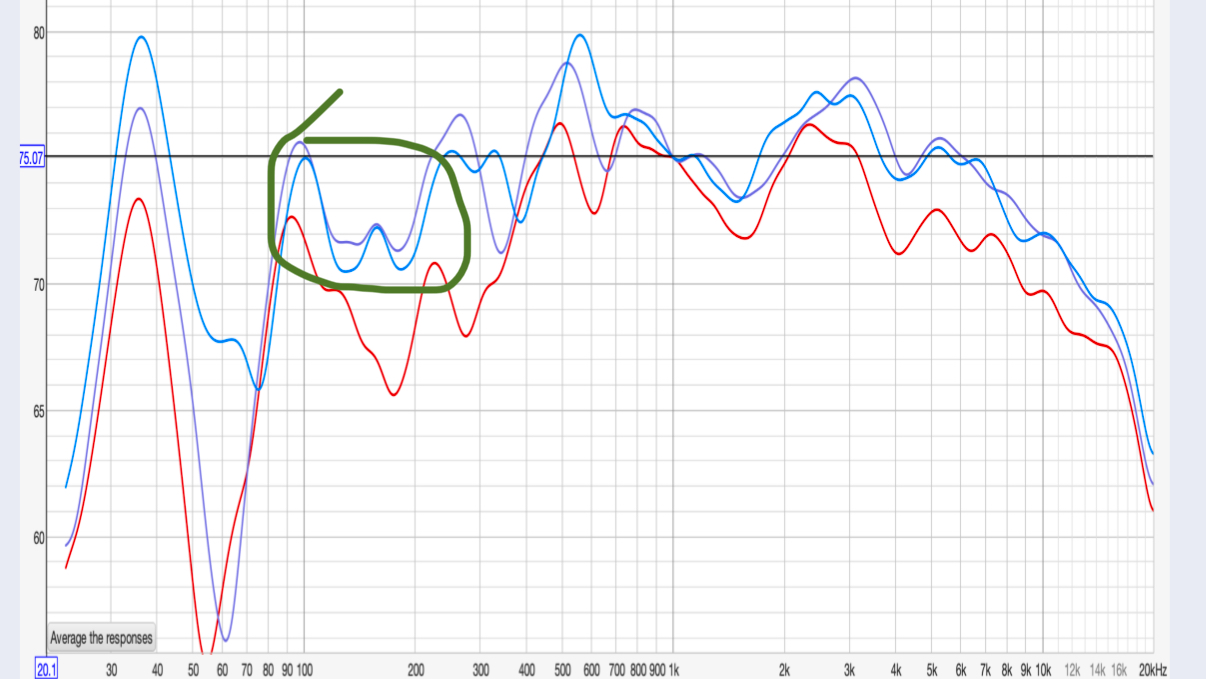@lemonhaze Great suggestions, thanks so much!
I’m assuming modest sized sealed subs would do for a room like mine. I see REL subs favored by a lot of audio people. Is this what you’d recommend?
Whay type of fill do you use for your triangular traps? And you’re saying build it horizontally and put it above my wall cabinets across the entire back wall at the interface between wall and ceiling? And you’d go as thick as I could go, up to and including 6” if I can swing it?
|
Yes build the traps as shown across the entire back wall. The colourful panels in the photos are DIY broad-band absorbers. Google has dozens of how to DIY examples. You need a few. And consider heavy drapes across that window.
See dimensions for bass trap construction from a previous post of mine, it's all there so no need for me to repeat. Once again google for DIY superchunk bass traps but do not go smaller than the sizes I provided. You will measure and hear the benefit and it's not small.
First off, if you want to be able to place the subs where you won’t fall over them then forget REL or any other sub that does not provide adjustable phase. REL subs only provide 0 or 180 degrees.
Let’s now look at that huge 35Hz peak caused by bass waves combining ’in phase’. Think of waves traveling towards the beach and remember how when secondary or tertiary waves catch up with those in front you get a larger wave form. That illustrates waves combining in phase, OK? So the exact same thing is happening in your room and it’s happening at 35Hz.
What if you could magically provide an antiphase 35Hz signal? problem solved, right? Well you can do exactly that by adjusting phase, SPL, crossover frequency, crossover slope, room gain and PEQ. You can tame the peaks and fill in the nulls. Sub number 2 will smooth things more.
Your speakers have ports so as an experiment plug them and see what happens to the response on REW and report back. There will be noticeable change,visually and audibly.
Before you spend on Dirac Live get yourself 2 x SVS SB 1000 PRO subs for about $600 each. Buy, beg or borrow. Adding subs does a lot more than just smooth the response, there is a performance gain across the spectrum.
As mentioned it’s not only SVS that can do this, many others available but the ones I suggest are IMO best value. Small compact units that also provide the remote App to allow adjustment from you armchair.
I have a 5m x 7m room opening to the kitchen and my small REL @#$$% and SVS fill my room with effortless detailed bass. The only reason I don’t have a 3rd sub is because we are going to sell the house.
I mentioned reading papers from Geddes, Toole and Welti. I strongly encourage you to google them up and read and learn from them.
|
BTW - if you are a ROON or JRiver user then Mitch's Convolution Filters are easy to use.
Honestly too hard and too much. Simple parametric EQs in Roon will solve the OP's problems.
|
Here is a plot of my room:

As you can see it looks a little bit better than yours. No 35Hz peak. The aberration between 100Hz and 250Hz is because I am not able to vary phase on the REL. The point being you will be able to get an even better in room response than mine by following my advice.
The above complies with the industry standard of +/_3dB up to the Schroeder frequency, the modal region.
Contrary to the advice above PEQ in Roon can not solve the overlong in-room decay, you need absorbers for that and PEQ does not absorb. How can it possibly know what frequencies need absorption and by how much. REW is the tool to help with that.
|
Those SVS subs are pretty cool - compact, sealed, and not too expensive.
I can take some measurements with ports plugged on my current speakers, but I really want to see how the curves look with my incoming bookshelf speakers before deciding how big my issues are on a baseline level as well as how much they it can be improved by tweaking LP and speaker location.
Meanwhile, I’ll do some homework to figure out how to build those superchunk traps.
|
OP
Something that I would look at is your room’s reverb time and if it’s excessive, fix that first. I have had good luck with GIK’s Polyfusor’s which defuse and reduce reverb time with a little bit of absorption. They also look better than the rectangular absorption products IMHO.
My experience with bass traps is they are better at fixing peaks in the 60-100 Hz range. They have to be quite substantial or use acoustic wizardly (Tube Traps) to get down to your room’s 35 Hz main resonance peak. I would address that peak with EQ. To avoid a digital conversion, you might consider an analog parametric EQ. You will notice the most improvement in movie playback by reducing this peak - bass will have impact instead of going "whump."
My current configuration includes bookshelf speakers (KEF R3 Meta, Dynaudio Contour 20) and Rhythmic SE12 subwoofers. The SE12’s include a band of analog parametric EQ. They are servo subwoofers so they work great with music. I am all digital these days, so I am rocking a MiniDSP SHD Studio. Applying DIRAC correction really focuses the image in my room. I would consider that icing on the cake after fixing reverb and bass.
![]()
|
Update to the thread. Here are 3 FR curves for my new-to-me Fritz LS7 Illuminator bookshelf speakers:

The difference in the curves are 3 different listening positions:
Red: 60" from back wall
Purple: 48" from back wall
Blue: 36" from back wall
The 35Hz peak isn't nearly as high as with the previous speakers (Monitor Audio Gold Reference 20) perhaps because the LS7's put out less quantities of bass vs the floor standing Monitors, but that 40-80Hz null is very much there and even in the "best" case at 36", it's down about 10dB from reference level. There's another dip around 100-250Hz or so.
As mentioned earlier, I'm very open to getting two audio-focused subs like the SVS SB-1000 Pro to fill in the nulls in the bass region if that will even out the bass response.
About the super chunk bass traps for the back wall - I measured and actually only have 12" between the top of the cabinets and the ceiling - not sure if a scaled down version of that makes sense there or is necessary with the new FR curves. I have about the same amount of room where the back wall meet the side walls, again constrained by the back cabinets.
Right now, I'm using big 26" high speakers as speaker stands, but will be getting 24" high real speaker stands tomorrow. I haven't tried to play with speaker location, they're still located 38" from the front wall and 28" from the side walls (at the 1/5 room width and depth location). Played with toe-in just a bit, but not a huge impact from what I could tell.
The ETC impulse peaks smoothed to 0.2ms show just one peak between 3-4ms around -14db or so, but all other peaks below -17dB.
Any thoughts are welcome as always.
As far as subjective listening impressions: They sound more forward in the upper mids/highs than the Monitors. At high volume, I want to tame them some. This is with grills off. With grills on, it seems to incrementally calm those forward frequencies some, but visually, I like the look without the grills much more, so will try to make adjustments as possible with grills off.
|
@captouch I guess physics does hold. Good that you've found out for yourself that as close to the front wall as possible is a better null reducer.
Also yes if you can DIY some corner wedges that are from corner floor to ceiling or even midpoint with this Rockwool - https://lumberbarn.com/products/rockwool-comfortbatt%C2%AE-stone-wool-insulation as the filling material.
But he's the two subwoofers are very important and you need to do the subwoofer crawl with mains when you get them
|
@kofibaffour So if the corner wedges are 12" x 12" x 17" (hypotenuse) and as long as needed to stretch from cabinet top to ceiling or on top of a cabinet between the ceiling and back wall - this size will still be beneficial?
FYI, it's actually further back into the room that reduces the major null. This 50-80Hz null is pretty much there with every speaker, but various in magnitude based on listening position. So it must be a room thing, as with the 35Hz peak.
|
Got a single SVS SB 1000 Pro and played with some of the settings. In conjunction with the variable loudness and 5 band EQ on my McIntosh C35 (I only tweaked one band), here’s my latest frequency response curve:

It’s zoomed in a fair amount so looks pretty lumpy, but the orange lines show the +/-3dB range and red lines the +/-5dB lines, so I’m mostly within 3dB except for the 100Hz and 575Hz peaks, ignoring the 28Hz peak as I think I can deal with that with the room compensation feature on the SVS and there’s likely little source material with musical info that low anyway (with my musical library).
So not bad at all. I’m not sure a second sub is really required, but am open to picking a second SVS up if I can find one for a good price.
|
I'm a firm believer that bass trapping can solve a lot of issues for little money and effort. Taming that low end helps a bunch as Eric pointed out.
My room response before and after bass traps and treatments:
https://www.audiogon.com/systems/10635#&gid=1&pid=10
That resulted in a +- 4.5 db range for my sweeps. I was told years ago that +-5 is a reasonable target for room response. If true, then I've told my pea brain to just hold tight and enjoy.
 My substantial bass traps were built as large as I could fit in the front corner spaces. As many have pointed out, corner traps like @lemonhaze are using are also employed in the rear. My substantial bass traps were built as large as I could fit in the front corner spaces. As many have pointed out, corner traps like @lemonhaze are using are also employed in the rear.
All of this is in my TN systems page photos. I failed at pasting in the graph photo here.
No matter what I do or how I measure I have not eliminated the 100 hz bump. I've considered a cheap equalizer to knock it down but really don't want another device in the chain. The room is like Mother Nature. It always prevails.
|
@bugredmachine Your system seems to have a little extra energy from 1-6kHz - does it seem a bit bright to you?
|
@captouch I don’t really feel that it is bright. I am a very analytical listener as well and like the air I get. Maybe that psyches me into a satisfaction level. My hearing is pretty decent to 14khz for an old man per the test 3 years ago.
You’ll notice that this region also attenuated 3 to 4 db just by taming the bass. At the time, new room, new speakers to me, and lots of first reflection treatments have helped the response. I’m not into tooting my own horn, but it sounds pretty awesome these days.
Cables can have a great impact, of course, but I have no listening fatigue after spending 3 years evaluating cables and "choosing wisely" for synergy.
Happy listening.
|
@captouch just curious are your speakers isolated or coupled to the floor and is it concrete or a suspended wood floor?
|
@goose The floor is a suspended wood subfloor finished with engineered wood planks.
The speakers are on Monoprice Monolith 24” metal stands with the four columns filled with sand. There are spikes on the bottom of the stands sitting on protective discs to protect the wood floor from the spikes.
There are currently very thin pads on the top of the stands, but I’m about to put some thicker (but not objectively thick) silicone pads on top mostly to provide some light resistance to sliding if the speakers are bumped.
I think blu tack could mar the bottom finish, which is what I wasn’t planning on going that route and will likely do the silicone pads instead.
|
@captouch the reason for asking is that have my audio room is on a second story suspended wood floor and was experiencing a bump in the 80 to 100 hz range that was a problem. The room has modest accoustic treatments (bass traps, first reflection and diffusion). I tried all kinds speaker changes including spiking, no spikes, limestone platforms with and without spikes and gliders. The key was to de-couple the speakers from the floor rather than coupling. It improved everything in the system via Townshend podiums. you might want to try some of the cheaper "spring" options out there to see if this may help your issues as a test.
|
@goose That’s very interesting, thanks for bringing it up.
So many possible tweaks to try!
|
@goose Do the Isoacoustics solutions (ISO-155 or Aperta) fit within the realm of decoupling that you suggested, or are those not really what you meant?
|
@captouch In keeping along the spring concept like Townshend, amazon has the nobsound or other spring puck like products for around $20 for four pucks. It's an inexpensive purchase to experiment. The Isoacoustics products are reported to be good and they have recently updated their isolation products. I prefer the Townshend products for speakers but they are more expensive. There are also other companies that provide de-coupling or isolation products but I don't have any experience with them.
|
@goose I just bought two packs of 4 and will try them out tomorrow!
|
@bugredmachine, I had computer problems and have only just resolved the issue. You have a lot of nice kit there and I had a look at your complaint about the 100Hz problem stubbornly remaining. I also noticed your REL subs.
REL unfortunately only provides 0-180 phase flip so you are limited in your ability to dial them in. It appears obvious to me that a different phase setting is required and that is only achievable with a sub that has variable phase adjustment.
My advice, and I'm sure you're not going to like it, is to get an additional sub that has variable phase. There are many on the market and if you do go for this then it should be a sealed box, not ported or with a passive radiator. You've seen me mention the little SVS SB1000 Pro. This is fun to use because you can dial it in from your listening position. It will allow you to flatten the 100Hz peak and provide a smoother response. Be prepared to move one of the REL subs if necessary. I do not get kickbacks from SVS 
You have a lot of energy higher up that could be tamed with a ceiling cloud. The beauty of the cloud is it does not get in the way and it deals with the worst reflections, those from above. As I'm sure you know, the further the absorption is away from the wall (ceiling) behind it the lower in frequency it absorbs so you can by adjusting that distance fine tune it while watching the results on the frequency graph. I assume you are making measurements using REW, if so call up the Waterfall plot (cumulative spectral decay) for info on Rt60 which would be about 300ms. A smooth decay is more important than absolutes.
|
@captouch, that last frequency plot you posted is a huge improvement on the one before it where you have a 20dB null. That's a lot of music that you were missing in the important 50-70Hz range.
Yes, of course the 35Hx peak is 'a room thing' so are all the other peaks and nulls/partial nulls. You don't mention what change you hear in the sound now with the one sub in place.
You wonder if a second sub is needed? Will it help more? Sure it will help more but only you can decide if you need it. Personally I wouldn't hesitate
|
@lemonhaze Thanks. It sounds good to me, filling in the lower parts of vocals quite noticeably so it goes from thinner/slightly nasal to more substantial and better balanced.
But here’s the thing: I’m having to set the SVS LPF all the way up to 200Hz. Because I’m trying to address the original 100-200Hz null from the mains:

If I cut off where you would normally cut off with a sub, that null stays there.
Is it a total disaster that I have to overlap the sub and mains by that much to fill out the null, even if the final curves look pretty good?
|






